Optimization of a Pumped-Storage Fixed-Head Hydroplant: The Bang-Singular-Bang Solution
Abstract
We consider the problem of the optimization of the functioning of a pumped-storage hydroplant. The problem can be mathematically formulated as an optimal control problem, and when the considered hydromodel is of the fixed-head type, an added complication arises: the solution is of the bangsingular-bang type. In this paper, we propose a simple and efficient optimization algorithm to find the solution.
1. Introduction
This paper has a clear aim: optimizing the functioning of a pumped-storage hydroplant, with the context of the decentralized Spanish electricity market [1].
In the literature (see [2, 3]), numerous simplifications are performed to model plants of this kind, in order to obtain an extremely simple mathematical formulation which permits the use of commercial packages of, for instance, linear programming. Readers are referred to [4], which constitutes an excellent list of over 100 of relevant research papers on the hydroplant modeling.
However, the optimization of pumped-storage hydroplants is a complex Dynamic Programming problem [5], with given time and final state. The problem can be mathematically formulated as a standard Lagrange-type optimal control problem [6]. In a previous paper [7] the authors considered a variable-head model for the pumped-storage hydroplant. The solution can be obtained using Pontryagin’s Maximum Principle [5]. In another previous paper [8] the authors considered a fixed-head model for a conventional hydroplant, without pumping capacity. The solution is of the bang-bang type, and the absence of singular arcs was proven. However, when the considered model is fixed head and pumped storage simultaneously, an added complication arises: the solution is of the bang-singular-bang type.
Different methods for determining optimal controls with a possibly singular part have already been developed. A popular approach introduced by Jacobson et al. [9] has been used by a number of researchers including Edgar and Lapidus [10, 11] and more recently by Chen and Huang [12]. This method involves solving the singular/bang-bang optimal control problem as the limit of a series of nonsingular problems. It is important to establish the limitations of these perturbation-based methods for practical problems. In fact, the convergence criterion described in [9] requires that the perturbation parameter, ε, be sufficiently small; however, numerical difficulties result when ε approaches a zero limit. The reader is referred to [12–14] for further details. Maurer et al. [15] presented a numerical scheme for computing optimal bang-bang controls. They assume that every component of the optimal control is bang-bang and that there are only a known finite number of switching times. Assuming that the optimal control structure is known, [16] formulates a new finite-dimensional optimization problem involving the initial states, the switching times, and the final time tf as optimization variables. Another idea is to guess a possible control structure and start with some additional bang-bang and singular arcs. The optimization approach will then lead to a solution where the lengths of all redundant arcs will be optimized to zero. Alternatively, the direct monotone structural evolution method [17] additionally takes advantage of the minimum principle optimality conditions to obtain the correct control structure. For the study of sufficient conditions, the reader is referred, for example, to [18, 19].
Faced with the existence of diverse general methods for bang-singular-bang problems, in this paper we have developed a specific algorithm for our problem. Our method needs no prior knowledge of the number and location of the bang-singular-bang arcs neither does it handle any parameter (like, e.g., discretization or a penalization factor) that has an influence on convergence or the precision of the result.
In this paper we propose a simple and efficient optimization algorithm to find the bang-singular-bang solution to our hydroproblem. Though we treat only a specific hydraulic problem, it should be noted that our method may be applied to other problems with the same characteristics. The paper is organized in the following way. In Section 2 we set out the corresponding mathematical problem. Section 3 summarizes the optimization algorithm based upon the previous mathematical fundaments. Finally, the results obtained in an example are presented in Section 4, and the conclusions reached in this study are discussed in Section 5.
2. Mathematical Optimization of a Pumped-Storage Hydroplant
In this section, we focus on the new short-term problem faced by a generation company, in a deregulated electricity market, when preparing its offers for the day-ahead market. Our model of the spot market explicitly represents the price of electricity as a known exogenous variable.
3. Algorithm
Based on the above theoretical results, in this section we describe the optimization algorithm.
The algorithm presents a series of advantages. First of all, our method needs no prior knowledge of the number and location of the bang-singular-bang arcs. Moreover (as we will see in the next section), it shows a rapid convergence to the optimal solution, and it can be run in a relatively short time due to the simplicity of the operations to be performed in this method.
- (i)
First, π(t) must be interpolated to obtain a continuous function.
- (ii)
Second, for a given λ, we have to determine the switching times: t1, t2, …. These instants are calculated solving
(3.1) - (iii)
Third, the optimal value λ0 must be determined in order for
(3.2)with and being the duration of the ith bang-bang segment in the upper and lower bound, respectively, Nu and Nl the number of such segments, and zλ(T) the final volume obtained for each λ. - (iv)
To calculate an approximate value of λ0, we propose a classic iterative method (like, e.g., bisection or the secant method).
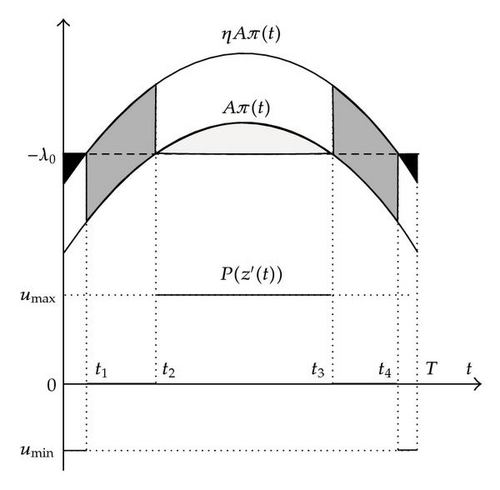
In the next section the proposed method is applied to an example.
4. Example
In this paper, we focus on the problem that a generation company faces when preparing its offers for the day-ahead market. Thus, the classic optimization interval of T = 24 h. was considered. The clearing price, π(t) (euros/h·MW), corresponding to one day was taken from the Spanish electricity market [1] (see Table 1). Note that in real electricity markets, the clearing price, π(t), is only known at each hour (t = 1,2, …, 24). In this paper the known values of π(t) were linearly interpolated with good results.
| t | π(t) | t | π(t) | t | π(t) | t | π(t) |
|---|---|---|---|---|---|---|---|
| 1 | 76.93 | 7 | 69.47 | 13 | 104.08 | 19 | 90.00 |
| 2 | 68.20 | 8 | 75.79 | 14 | 100.00 | 20 | 106.89 |
| 3 | 68.20 | 9 | 105.90 | 15 | 80.50 | 21 | 103.00 |
| 4 | 60.00 | 10 | 106.50 | 16 | 78.23 | 22 | 100.00 |
| 5 | 55.01 | 11 | 110.00 | 17 | 75.93 | 23 | 86.93 |
| 6 | 56.28 | 12 | 108.46 | 18 | 78.23 | 24 | 79.93 |
The solution may be constructed in a simple way by taking into account the above algorithm. We shall perform two tests.
4.1. Influence of the Efficiency
First, we consider the restriction on the volume: b = 2 · 106 (m3) as a fixed datum and then we proceed to analyze the influence of the efficiency, η. In Table 2 we present the optimal profit when the efficiency falls within the 1.35 to 1.15 range. We show the amount of pumped water and the improvement in profit with respect to the case without pumping.
| η | Profit (euros) | Pumped water (m3) | % improvement |
|---|---|---|---|
| without pumping | 27145.2 | 0 | 0 |
| 1.35 | 30282.5 | 1.49123 · 106 | 11.6 |
| 1.30 | 30896.4 | 1.61463 · 106 | 13.8 |
| 1.25 | 31567.5 | 1.7438 · 106 | 16.3 |
| 1.20 | 32300. | 1.87975 · 106 | 18.9 |
| 1.15 | 33105.5 | 2.07863 · 106 | 21.9 |
| b (m3) | Profit (euros) | Profit (euros) | % improvement |
|---|---|---|---|
| (without pumping) | (with pumping) | ||
| 1 · 106 | 13753.1 | 20633.9 | 50.0 |
| 2 · 106 | 27145.2 | 32300 | 18.9 |
| 3 · 106 | 40067.6 | 43318.3 | 8.1 |
| 4 · 106 | 52017.6 | 53733.1 | 3.3 |
As can be appreciated, significant improvements in profit of between 12–14% are obtained for even very poor efficiencies (in the 65–75% range). For the normal efficiency of pumped plants of around 80%, the improvement in profit is quite substantial, being around 20%.
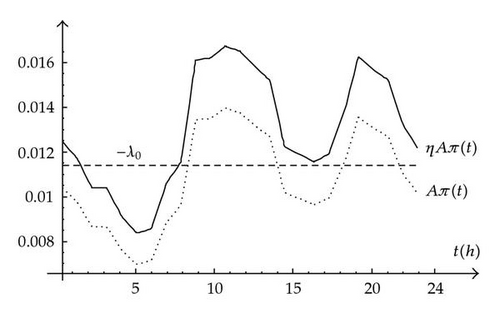
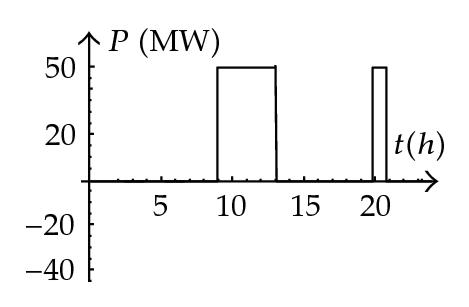
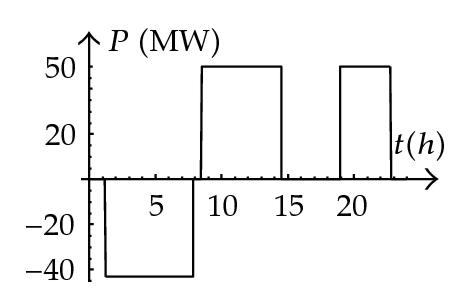

It can clearly be seen that when η = 1.2 (standard efficiency of 80%), the plant pumps during the most off-peak period in the clearing price π(t). However, when η = 1.15, and hence the efficiency increases to 85%, the plant also pumps in the small off-peak period in the clearing price π(t) that usually occurs around 17.00 h.
The singular arcs correspond to what, in a previous paper [24], we called a smooth transition. This is a qualitative aspect of the solution of the problem. The discontinuity of the derivative of the Lagrangian does not translate as discontinuity in the derivative of the solution. In fact, it is verified that the derivative of the extremal where the minimum is reached presents an interval of constancy.
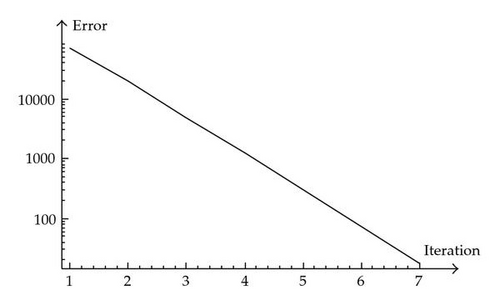
4.2. Influence of the Volume Available
Second, we consider the efficiency η = 1.2 as a fixed datum, and then we proceed to analyze the influence of the restriction on the volume b. We compare with the solution without pumping.
As can be seen (see Table 1), the more the water available in the reservoir, the lower the profit obtained from pumping it. In fact, if the average flow of the river was such that volumes of water of 4 · 106 (m3) were available, it would not be of interest to consider building a pump plant.
This type of study is very interesting when designing the most suitable type of plant for each hydrographic basin.
5. Conclusions
In this paper we have presented a simple and efficient optimization algorithm to optimize the functioning of a pumped-storage hydroplant. When the hydroplant is of the fixed-head type, the optimal solution presents a very particular form: the bang-singular-bang solution. Faced with the existence of diverse general methods for bang-singular-bang problems, in this paper we have developed a specific algorithm for our problem. Our algorithm allows the optimal solution to be obtained easily. The obtained results provide real-time information to determine which configuration is preferable in each specific real situation of the electricity market. Our theoretical results have been illustrated with numerical examples.
As to future perspectives, in spite of having presented a hydraulic example in this paper, it should be noted that our method may be applied to other problems with the same characteristics, with a constant value of the adjoint. Another interesting future line of study could be that of adapting the technique present in [19] to our hydraulic problem. In this paper the authors present an application to a free-flying robot, where it has been shown that the singular arc of the control can be interpreted as a bang-bang control of a so-called augmented smooth control problem.
Acknowledgment
This work was supported by the Spanish Government (MICINN, Project: MTM2010-15737).




